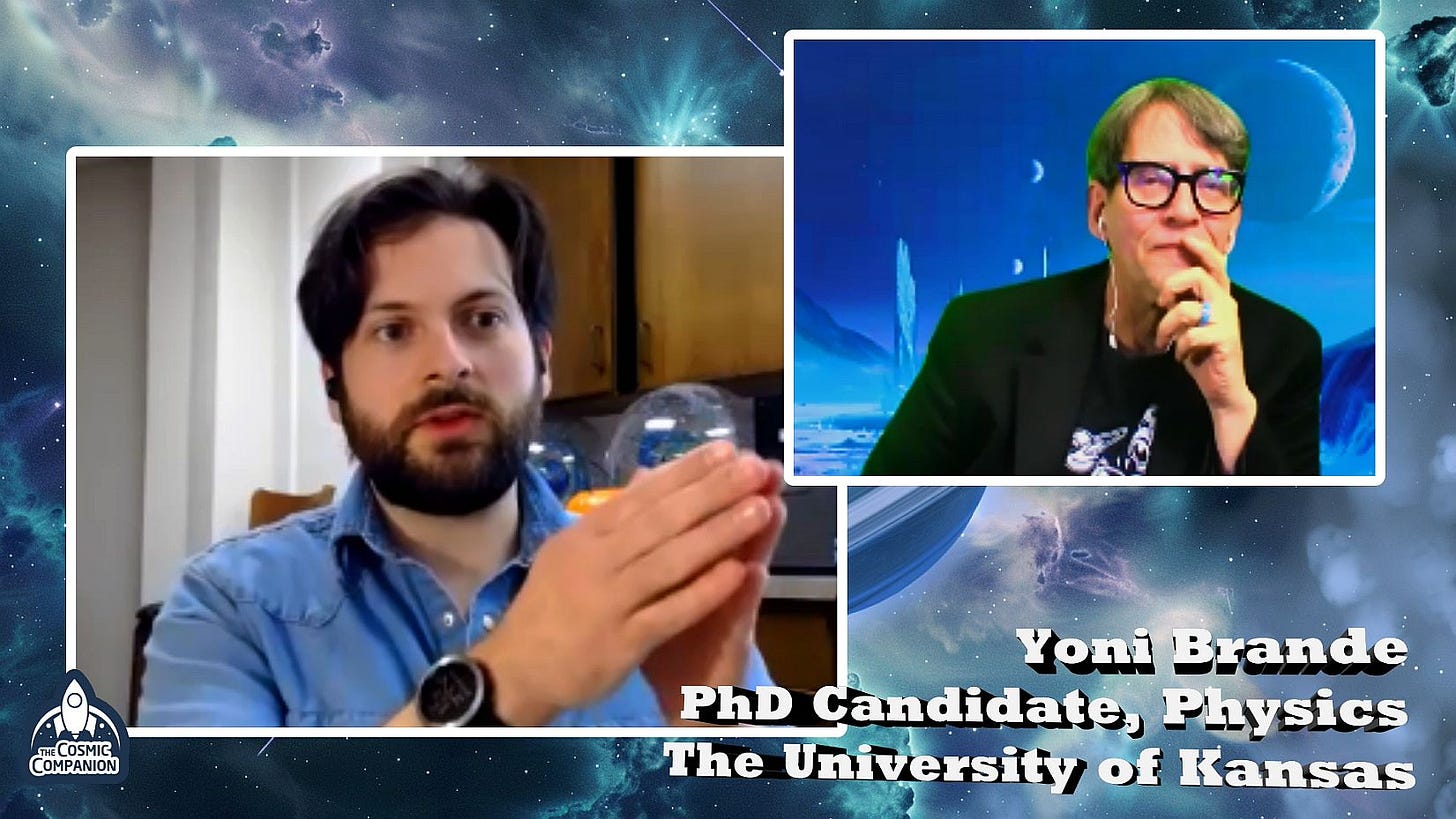Hello everyone!
Welcome back to The Cosmic Companion. I am James G. Maynard.
This week, we’re venturing into the chilly outskirts of our solar system and beyond, exploring the mysterious worlds of ice giants. Later in the show, we’re going to talk with Yoni Brande, PhD candidate at the University of Kansas, talking about these chilly worlds.
So — what are ice giants, I hear you ask.
[What are ice giants?] Thanks…
Ice giants are like the cool cousins in our solar system family. They’re not as flashy as the gas giants, Jupiter and Saturn, but they’ve got a charm all their own. You likely know about Uranus and Neptune, our resident ice giants!
These planets are called “ice” giants because they have a lot of water, ammonia, and methane, which, in the frigid depths of space far from a star, freeze into ice. But these aren’t giant snowballs! These ices form a hot, dense fluid in the planet’s deep interior, surrounding a rocky core.
Uranus, the “sideways planet,” spins on an axis nearly parallel to its orbit. It’s like it’s rolling around the sun!
[I must be me!]
And Neptune, the furthest planet from the sun, has the strongest winds in the solar system, reaching speeds of 2,200 kilometers per hour. That’s faster than most jet aircraft!
But guess what? Our solar system doesn’t hold the monopoly on these frosty worlds. They’re found sprinkled across the universe in other planetary systems as well!
Our story begins with the discovery of Uranus in 1781 by William Herschel, who initially thought he’d found a comet. Imagine his surprise when it turned out to be a whole new planet!
[Herschel: Wow! It’s a whole new planet!]
Uranus thus became the first planet discovered using a telescope.
This world is accompanied by 28 known moons, including five large ones. Each are named after a character from literature, usually from Shakespeare.
[What about Neptune?]
Now, French mathematician Urbain Joseph Le Verrier first calculated the position of an unseen planet in 1846, and astronomer Johann Gottfried Galle found the planet after less than a night of searching, less than a single degree from its predicted position.
[My. That was fast!]
Yes, it was.
Our understanding of these icy worlds has come a long way since then. We’ve gone from thinking of them as distant, featureless blue orbs to recognizing their dynamic atmospheres and complex internal structures. It’s like getting to know someone on a deeper level, except that someone is a giant icy ball at the far end of the Solar System!
Next up, we talk with Yoni Brande, a PhD candidate at The University of Kansas, who studies these fascinating worlds.
Now, let’s take our ice giant love affair interstellar. Welcome to the world of exoplanets — planets outside our solar system. The hunt for exoplanets has turned up some fascinating characters, including quite a few ice giants!
With each new discovery, we’ve learned more about these intriguing worlds. Some are super-sized versions of Neptune, while others are like nothing we’ve seen before.
On some of these worlds, enormous atmospheric pressures press methane into diamonds which rain down through the air.
Mmm. hmm. Absolutely.
Our current understanding of these exoplanets is still evolving. It’s a bit like trying to understand a book by reading a single page. But every new discovery adds another piece to the puzzle, helping us understand the diversity and complexity of the universe.
As we continue to explore the cosmos, who knows what we’ll find next? Maybe an ice giant with rings like Saturn, or one with moons that might harbor life. The universe is full of surprises, in’t?
On 8 April, a solar eclipse will be seen over much of the United States. Next week on The Cosmic Companion, we will open the first half of our two-part series on eclipses, From Twilight to Totality: The Science of Eclipses with Stephen Wolfram. We’ll talking with Stephen Wolfram, developer of Wolfram-Alpha and Mathematica about his new book, Predicting the Eclipse.
Make sure to join us on 23 March, wherever you found this episode. Subscribe, follow, share, and never miss an episode, nor a film. Keep tuned for an upcoming announcement about our new upcoming film, The Wizard and the Scholar (or a Rapscallion Runs Amok in Rye), coming out this summer.
Clear skies!
James
VIP Subscribers: Look below for our first preview of our upcoming film, The Wizard and the Scholar (or a Rapscallion Runs Amok in Rye). Enjoy!
Listen to this episode with a 7-day free trial
Subscribe to The Cosmic Companion w/ James Maynard to listen to this post and get 7 days of free access to the full post archives.



















